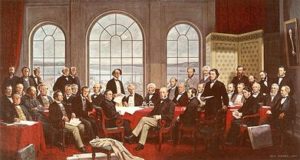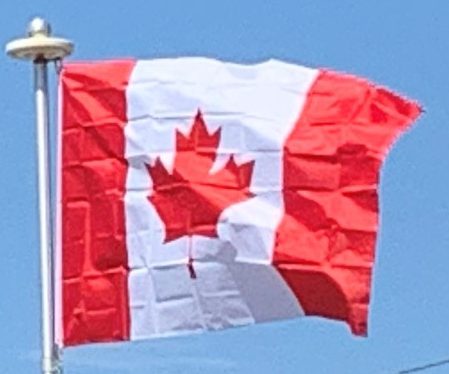The desire for responsible government resulted in the abortive Rebellions of 1837. The Durham Report subsequently recommended responsible government and the assimilation of French Canadians into English culture. The Act of Union merged the Canadas into a united Province of Canada and responsible government was established for all provinces of British North America by 1849. The signing of the Oregon Treaty by Britain and the United States in 1846 ended the Oregon boundary dispute, extending the border westward along the 49th parallel. This paved the way for British colonies on Vancouver Island (1849) and in British Columbia (1858). The Alaska Purchase of 1867 by the United States established the border along the Pacific coast, although there would continue to be some disputes about the exact demarcation of the Alaska-Yukon and Alaska-BC border for years to come.
Confederation and Expansion:
Following several constitutional conferences, the Constitution Act officially proclaimed Canadian Confederation on July 1, 1867, initially with four provinces: Ontario, Quebec, Nova Scotia, and New Brunswick.

Canada assumed control of Rupert’s Land and the North-Western Territory to form the Northwest Territories, where the Métis‘ grievances ignited the Red River Rebellion and the creation of the province of Manitoba in July 1870. British Columbia and Vancouver Island (which had been united in 1866) joined the confederation in 1871, while Prince Edward Island joined in 1873. Between 1871 and 1896, almost one quarter of the Canadian population immigrated southwards, to the U.S.
To open the West to European immigration, parliament also approved sponsoring the construction of three transcontinental railways (including the Canadian Pacific Railway), opening the prairies to settlement with the Dominion Lands Act, and establishing the North-West Mounted Police to assert its authority over this territory. In 1898, during the Klondike Gold Rush in the Northwest Territories, parliament created the Yukon Territory. Alberta and Saskatchewan became provinces in 1905.
Early 20th Century:
Because Britain still maintained control of Canada’s foreign affairs under the Constitution Act, 1867, its declaration of war in 1914 automatically brought Canada into World War I. Volunteers sent to the Western Front later became part of the Canadian Corps, which played a substantial role in the Battle of Vimy Ridge and other major engagements of the war. Out of approximately 625,000 Canadians who served in World War I, some 60,000 were killed and another 172,000 were wounded. The Conscription Crisis of 1917 erupted when the Unionist Cabinet’s proposal to augment the military’s dwindling number of active members with conscription was met with vehement objections from French-speaking Quebecers. The Military Service Act brought in compulsory military service, though it, coupled with disputes over French language schools outside Quebec, deeply alienated Francophone Canadians and temporarily split the Liberal Party. In 1919, Canada joined the League of Nations independently of Britain, and the 1931 Statute of Westminster affirmed Canada’s independence.
The Great Depression in Canada during the early 1930s saw an economic downturn, leading to hardship across the country. In response to the downturn, the Co-operative Commonwealth Federation (CCF) in Saskatchewan introduced many elements of a welfare state (as pioneered by Tommy Douglas) in the 1940s and 1950s. On the advice of Prime Minister William Lyon Mackenzie King, war with Germany was declared effective September 10, 1939, by King George VI, seven days after the United Kingdom. The delay underscored Canada’s independence.
